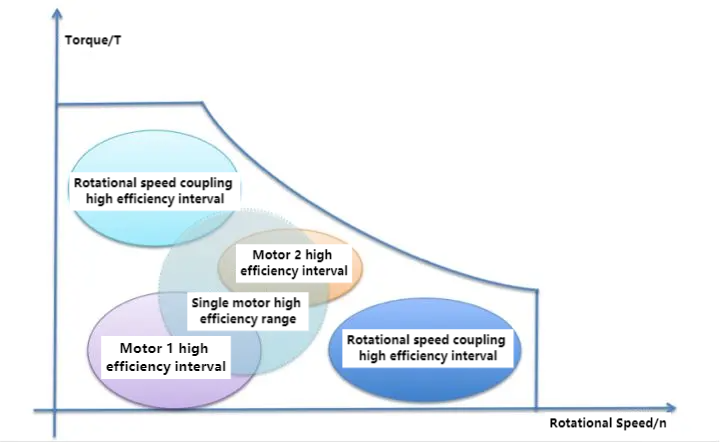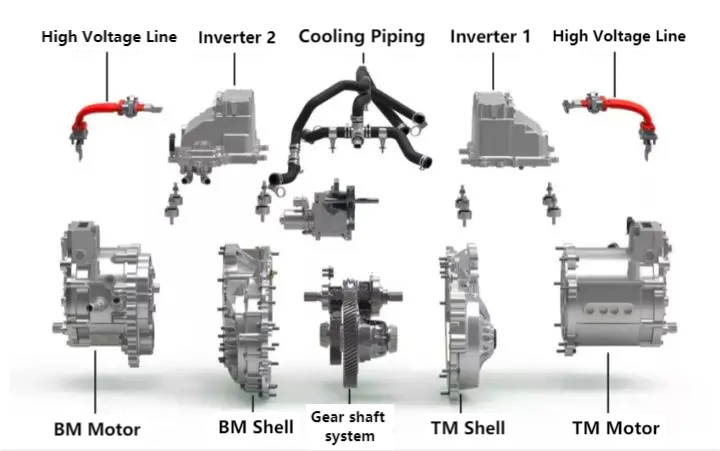I don't need to say much about the importance of electric car range, not only will people not buy a short range, but the state subsidies are also less, so the major manufacturers are desperately trying to find ways to improve the range. However, with no major progress in battery technology, the huge weight and high cost of the battery pack means that it is not a wise choice to just stack batteries.
Then what to do? Improve drive efficiency! That is to say: cherish and rational use of each degree of electricity, is the key to improve the range of battery technology is not a huge progress.
For electric vehicles, dual motors have considerable advantages over single motor plus main gearbox or gearbox solutions in terms of improving drive efficiency for four reasons.
First, the efficiency of a single motor is more severely reduced at low speeds, high speeds with light loads, etc.
Although the high efficiency range of electric motor is much larger than that of internal combustion engine, the speed and torque requirements of automobile are too wide: strong acceleration performance and climbing ability need large torque, while the speed from 0 to hundreds of kmh has very high requirements on speed range. Although the efficiency of electric motor can be very high in most of medium and high speed working conditions, but in the case of low speed heavy load, low speed light load, high speed light load, etc., the electric motor efficiency will drop 20 to 30% than the high efficiency range. Dual motors, on the other hand, can be used in different combinations to greatly expand the high efficiency range of the system and improve the efficiency at high speed and light load, etc.
Second, dual motors can improve the efficiency of braking energy recovery.
Drive efficiency and recovery efficiency are actually the same thing, when the motor works in electric mode is the drive efficiency, when it works in power generation mode is the recovery efficiency, two motors have more high recovery efficiency interval, which can improve the efficiency of brake energy recovery.
Third, the dual motor has no power interruption.
A single motor to achieve higher efficiency can be achieved by matching a multi-gear gearbox, but if you match the gearbox, there will be the problem of power interruptions in gear changes, while the use of dual-motor coordinated control will not have power interruptions.
Fourth, a single motor is difficult to design and manufacture and has a large total weight if it is to meet high performance (i.e., high torque) and high speed range.
By breaking a single motor into two motors, the motor can be made less difficult to manufacture and the total weight can be reduced. In fact, the performance of a 100kW motor does not need to be provided by a 60kW motor and a 40kW motor combined. Typically, a dual motor system with a 40kW or so and a 30kW or so motor can provide even more performance than a 100kW motor, while the total weight can typically be reduced by 30% or more.
Of course, not everything is better with dual motors, although there are big improvements in terms of efficiency and guaranteed performance with dual motors, but dual motors are more complex in structure compared to single motors, requiring more complex power coupling devices and more sophisticated control algorithms.
Dual motor drives can be divided into the following types according to the way the two motors are power coupled.
1、Torque coupling
As the name implies, torque coupling is the sum of the torque of two motors. The output torque of the power system is the sum of the torque of the two motors, but the speed of the two motors is the same (or a fixed ratio). As we know, each motor has a high efficiency interval, and torque coupling allows the system to add another high efficiency interval to the respective high efficiency intervals of the two motors, reaching three high efficiency intervals. The advantage of this system is the simple structure, for example, one motor can drive the front axle and one motor can drive the rear axle, and the control algorithm is also simpler, Tesla uses this kind of system.
2、Torque coupling
According to the definition of torque coupling, it is estimated that it is easy to understand the rotational speed coupling. Rotational speed coupling is the system output speed is the sum of the speed of the two motors, but the torque of the two motors is the same (or fixed proportion). By the same token, the two motors work in the high-efficiency range, and the system adds another high-efficiency range, reaching three high-efficiency ranges. Speed coupling generally uses planetary gears as the coupling mechanism, and the structure is a little more complicated. This method has a small torque, so it is generally suitable for micro cars with light loads and small load variations.
3、Torque speed dual coupling
Dual coupling (also known as hybrid coupling) is through more complex power transmission components, so that the two motors can achieve both torque coupling and speed coupling, so that the high efficiency working interval of the two motors, in the case of speed coupling and torque coupling, each increase a high efficiency interval, thus reaching four high efficiency intervals.

In a comprehensive view, the dual-coupling approach is certainly the most obvious advantage, and the greatest improvement in efficiency, the disadvantage is that the control is more complex, the control algorithm considers more variables, and the technical difficulty is greater.
There are still many dual-motor models on the market, such as the Tesla Model S, NIO ES8, BYD Tang, and Roewe eRX5, and new models such as the Jaguar I-PACE are also equipped with dual-motor drive systems. The performance of these models is good, for example, the maximum torque of Model S 75D reaches 525Nm and the acceleration of 100km is 4.4s; the maximum torque of Roewe eRX5 reaches 704Nm and the acceleration of 100km is 7.5s; the maximum torque of Jaguar I-PACE reaches 696Nm and the acceleration of 100km is 4.8s; the maximum torque of NIO ES8 reaches 840Nm This shows that the dual motors can provide a strong performance.
Let's talk about the dual motor drive method of Marvel X. After reading this part, you will understand why it is so efficient.
Marvel X adopts the dual-coupling method mentioned earlier in order to improve efficiency. In order to achieve acceleration of about 7s, a drive motor of roughly 140kW is required, which is driven by a dual motor, using an 85kW main drive motor (TM) and a 52kW auxiliary drive motor (BM), where the TM motor is always connected to the wheels and the BM motor is accessed on demand through a two-speed gearbox, called the DM EDS system, which is structured as follows.

Let's see how these two motors work together under different working conditions to achieve higher efficiency.
In the low-speed stage, the TM motor works, and when strong acceleration is needed, the BM motor is connected to the 1st gear access, and the two torques are coupled, and the superimposed torque easily achieves a 100km acceleration of about 7s.
In the middle and high speed stage, the system automatically selects the working motor according to the working condition, so that the system is always in the high efficiency range.
In the high speed and light load stage, the system connects the BM motor to the 2nd gear, and through the speed coupling, the two motors can still work in the high efficiency range at this time.
Through the coordinated cooperation of the two motors under these different working conditions, the whole system can work in the high efficiency zone to the maximum extent at different vehicle speeds and load zones, and the overall efficiency is improved by about 10%, which ensures both the performance demand and the range of the system, and the electricity consumption is reduced to 14.2 degrees per 100km. This is why the Marvel X uses only 70% of the power of the Tesla (Model S 75D) to achieve a similar actual range (400km). Of course, the Tesla Model S 75D uses an asynchronous motor, and as I said in my previous article, the efficiency of the asynchronous motor is not as good as the permanent magnet synchronous machine, and the power density is not dominant, but its overload capacity is stronger, so the performance of the Model S 75D still has a considerable advantage. At the same time, the asynchronous motor used in the Model S 75D has significantly lower efficiency at low speeds, which is why the range of the Model S in China is greatly reduced: there is less traffic congestion in the United States, and the low-speed working conditions will be less, while in China, especially in big cities, there is more congestion, and in this case, the efficiency of the Model S drops more.
Compared to pure electric vehicles of the same or similar price range, the Marvel X has obvious advantages: BYD Qin, which is in the 30W range, has a battery pack capacity of 60.48kWh, uses a single motor of 120kW, has a range of 400km, a maximum torque of 310Nm, and accelerates 7.9s per 100km, which is very close to the Marvel X. However, its battery pack is 10% larger than that of the Marvel X. The higher-priced NIO ES8, with a 70kWh battery pack and dual front and rear motors, has a maximum torque of 840Nm and a 4.37s acceleration over 100km because it uses an AC asynchronous motor, but its range is only 355km with a 25% larger battery pack than the Marvel. The range is said to be even lower. This shows that the drive efficiency of Marvel is very high and the performance is relatively balanced, and in a comprehensive view, it is an electric car with no shortcomings.







